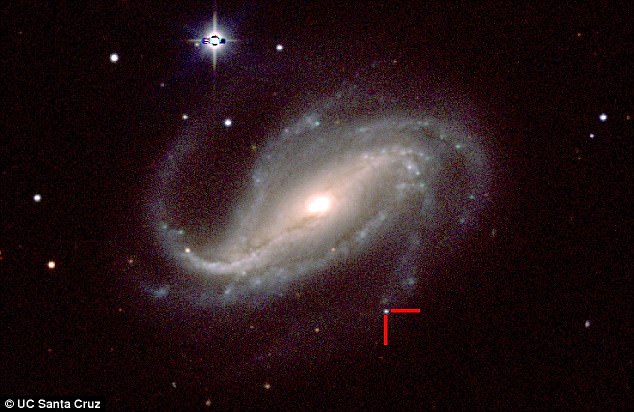The first burst of light given off by an exploding star has been captured for the first time by an amateur astronomer in Argentina.
Observations of a dying star 80 million light-years away, taken by Víctor Buso, 60, has given scientists their first view of the initial flash given off by a supernova.
To date, no one has been able to capture the ‘first optical light’ from a supernova, since stars explode seemingly at random in the sky, and the burst is fleeting.
Most are only spotted a long time after the initial blast, making Mr Buso’s one-in-ten-million observations ‘unprecedented’, scientists said.

The new data provide important clues to the physical structure of the star just before its catastrophic demise and to the nature of the explosion itself.
‘Professional astronomers have long been searching for such an event,’ said University of California at Berkeley astronomer Dr Alex Filippenko, who followed up the lucky discovery with scientific observations of the explosion, called SN 2016gkg.
‘Observations of stars in the first moments they begin exploding provide information that cannot be directly obtained in any other way.’
‘It’s like winning the cosmic lottery.’
During tests of a new camera, Mr Buso snapped images through his 16-inch telescope of the galaxy NGC 613, which is 80 million light-years from Earth.
He took a series of short-exposure photographs of the spiral galaxy, accidentally capturing it before and after the supernova’s ‘shock breakout’.

This is when a pressure wave from the star’s exploding core hits and heats gas at the star’s surface to a very high temperature, causing it to flash and rapidly brighten.
Upon examining the images, Mr Buso, of Rosario, Argentina, noticed a faint point of light quickly brightening near the end of a spiral arm that was visible in his second set of images but not his first.
Astronomer Dr Melina Bersten and her colleagues at the Instituto de Astrofísica de La Plata in Argentina soon learned of the serendipitous discovery.
They realised that Mr Buso had caught a rare event, part of the first hour after light emerges from a massive exploding star.
She estimated Mr Buso’s chances of such a discovery, his first supernova, at one in 10 million or perhaps even as low as one in 100 million.
Dr Bersten contacted an international group of astronomers to help conduct additional frequent observations of SN 2016gkg.
A series of subsequent studies have revealed more about the type of star that exploded and the nature of the explosion.
Mr Buso’s discovery, snapped in September 2016, and results of follow-up observations have now been published in the journal Nature.
‘Buso’s data are exceptional,’ Dr Filippenko added.
‘This is an outstanding example of a partnership between amateur and professional astronomers.’
The astronomer and his colleagues obtained a series of seven spectra, where the light is broken up into its component colours, as in a rainbow.
They used the Shane 3-meter telescope at the University of California’s Lick Observatory near San Jose, California, and the twin 10-meter telescopes of the W. M. Keck Observatory on Maunakea, Hawaii.
This allowed the international team to determine that the explosion was a Type IIb supernova: The explosion of a massive star that had previously lost most of its hydrogen envelope.
Combining the data with theoretical models, the team estimated that the initial mass of the star was about 20 times the mass of our Sun.
They suggest it lost most of its mass to a companion star and slimmed down to about five solar masses prior to exploding.
Further analyses of the signal could provide further information on the star’s structure and uncover more secrets about supernovas.












